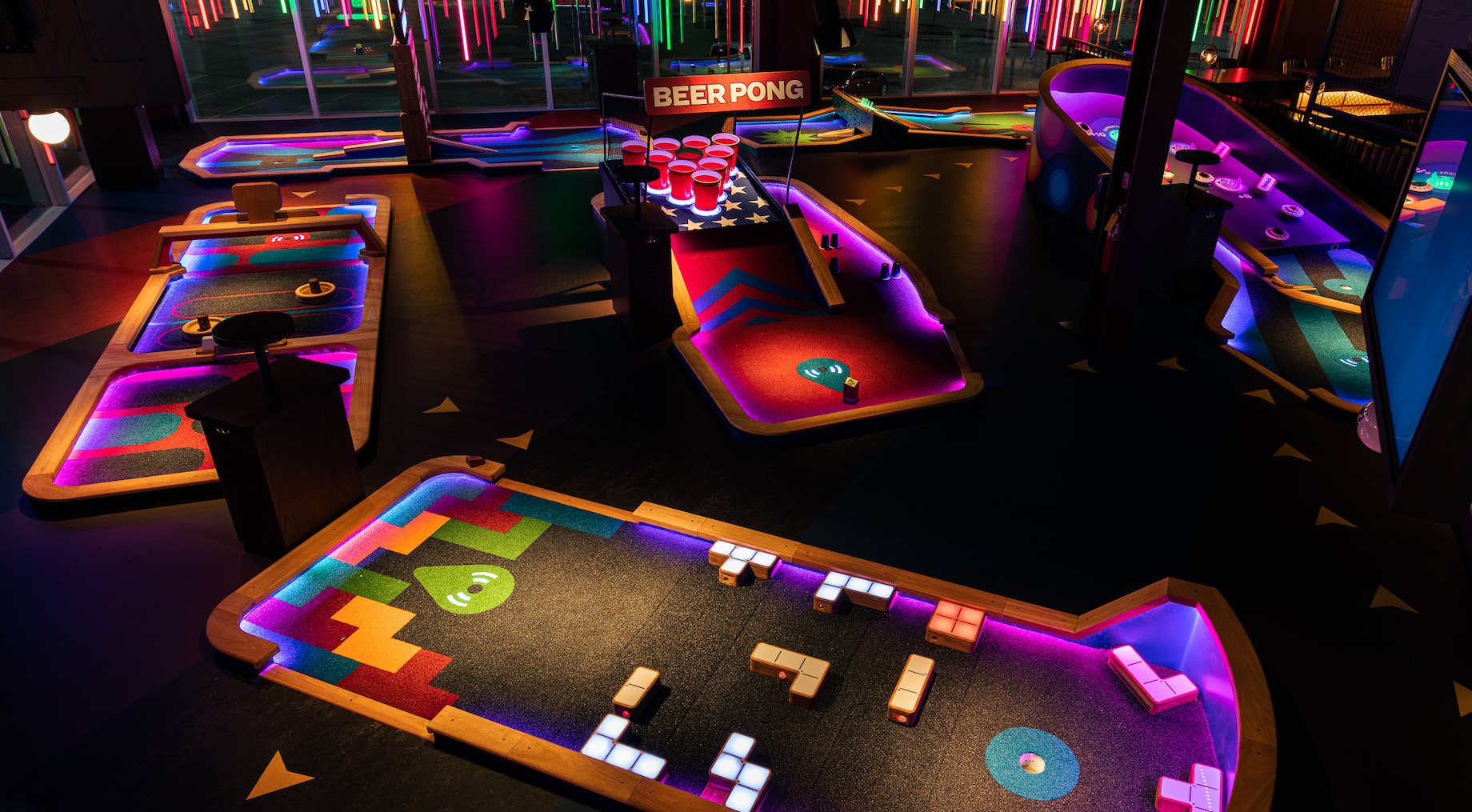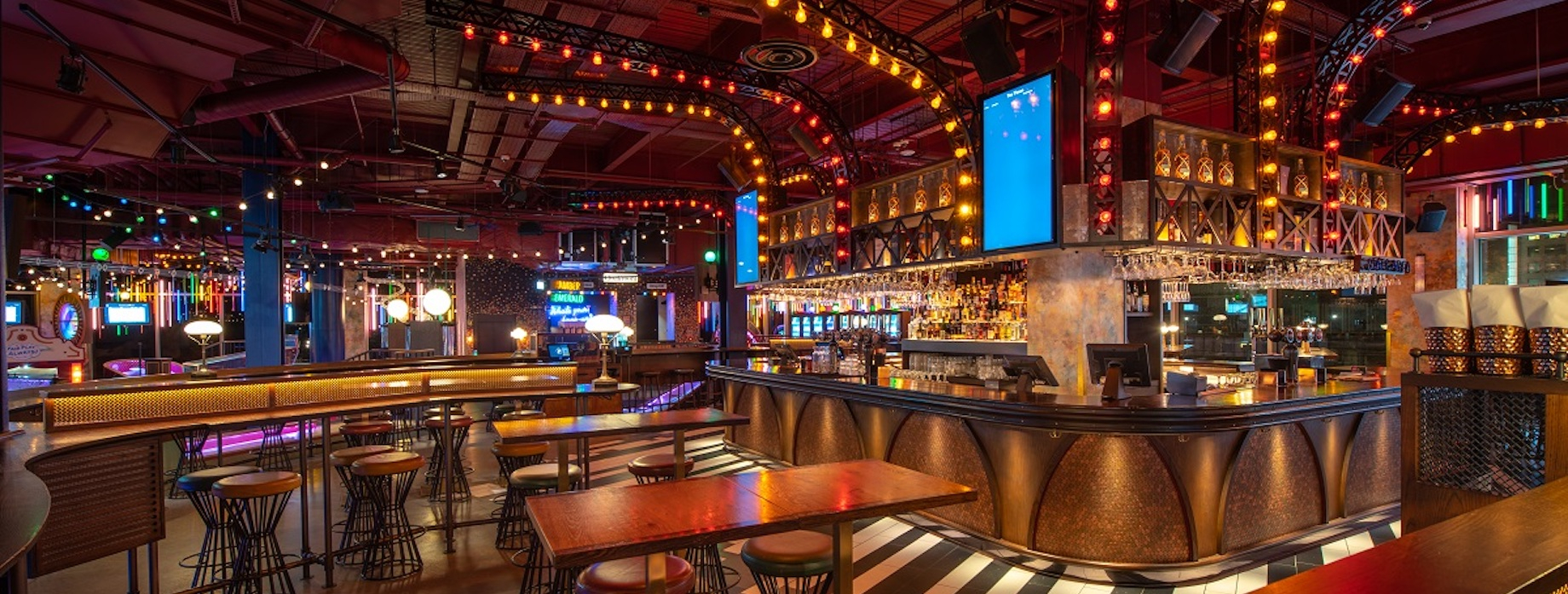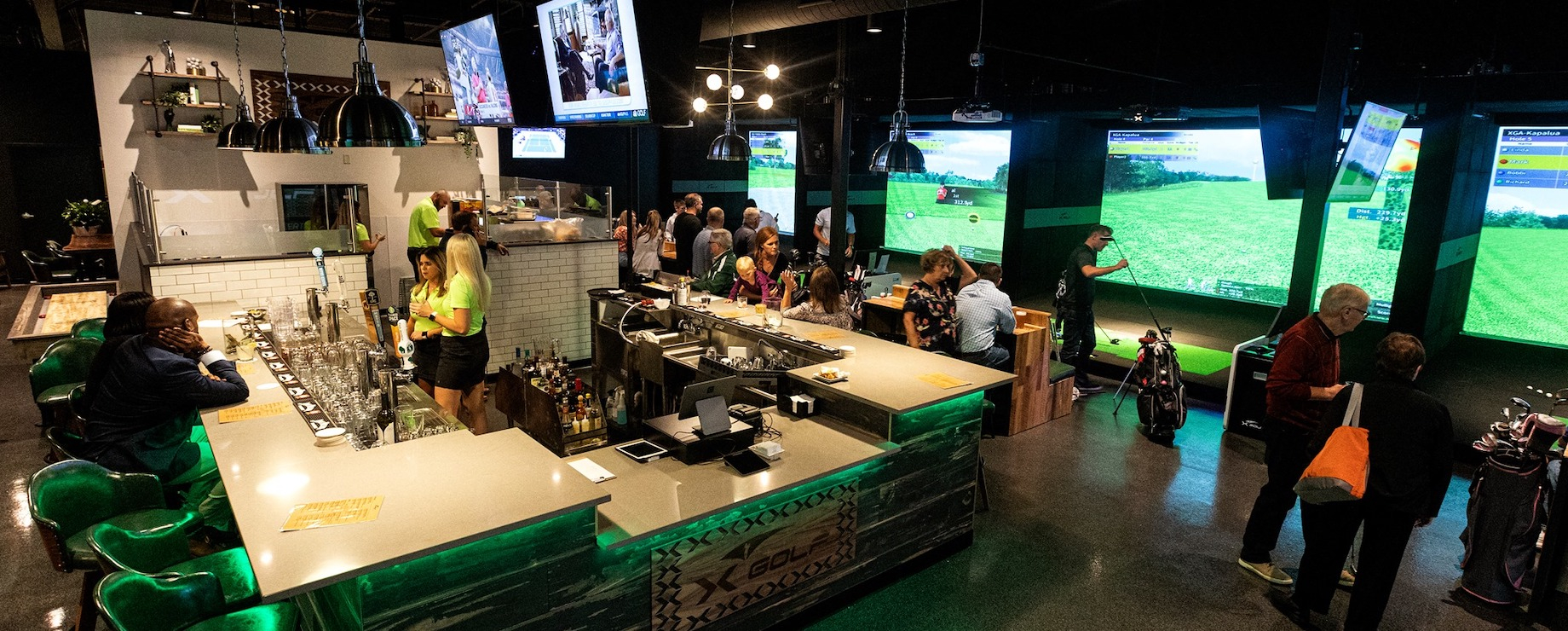Add golf to the “eatertainment” options for shopping center owners. Operators successfully have combined bowling, ax throwing, darts and other activities with high-end restaurants, bars and nightclubs. Now, a handful of high-tech mini-golf and golf-simulation concepts — including Puttshack, Puttery, PopStroke, X-Golf America and Five Iron Golf — are rapidly expanding.
They hope to replicate the success of multilevel urban driving range Topgolf but with smaller productions. Unlike Topgolf, which requires a dozen or more acres and a deep capital commitment to develop typically standalone locations, these operators are targeting retail centers, urban storefronts and even sports venues for 15,000 to 25,000 square feet units, placing less capital at risk.
The upstarts are teeing off at an opportune time: People largely have put COVID in the rearview mirror, at least for now; corporate events like team building are on the upswing as workers return to offices; and consumers are fueling the growth of “off-course” golf experiences. The number of off-course participants increased 19% to 9.9 million over the three years ending 2019, but participation grew 25% to 12.4 million during the following two pandemic years, according to the National Golf Foundation. “Many of these brands were incubated before COVID, but the trend is starting to take off,” said, CBRE senior vice president Jessica Curtis, who specializes in emerging brands as leader of the brokerage’s restaurant practice. “They are a little bit different than what we’ve seen with experiences like ax or dart throwing because golf certainly has a much bigger following and there are probably significantly more dollars spent on golf. Frankly, I’m surprised that the trend hasn’t come about sooner.”
While the differences between mini-golf, driving ranges and simulators are evident, nuances exist within each category. Some appeal more to golfers or those who are interested in learning to play, while others aim for a broader audience. The trick for landlords, Curtis said, is to parse the differences and decide what is best for their centers. “There’s more subtlety between these concepts than meets the eye,” Curtis said. “It feels very competitive, and our industry is wondering which one will come out as a leader in the space.”
Contenders for Golf Experience Market Share
Puttshack is an indoor mini-golf, entertainment and food-and-beverage concept spearheaded by Topgolf founders Steve and Dave Jolliffe and others. It offers four nine-hole courses, splashy colors and lighting, music, cocktails and dining, as well as a patented smart ball that links to the player and automatically keeps score. The company opened two U.S. locations last year and aims to open seven this year and 12 in 2023, said CEO Joe Vrankin. The experience typically will cater to families and corporate events during the day and transition to a nightclub, he added. “Just as Topgolf created a way to golf in an off-course environment, Puttshack has created a way of playing miniature golf that is totally different than how we used to play it as kids,” said Vrankin, who previously served as CEO of Topgolf. “That in itself creates a new interest level, and with our technology, we can continue to enhance the game without having to necessarily physically change the course.”

Puttshack, pictured here at Illinois’ Oakbrook Center and at top, includes not only mini-golf courses but also cocktails and dining.

Puttery is a tech-enabled mini-golf, entertainment, bar and restaurant concept from Drive Shack, a former REIT backed by Fortress that also operates four Topgolf-like driving ranges and 55 traditional golf courses. Puttery has opened two locations and aims to open 50 by the end of 2024, Drive Shack CEO Hana Khouri said during the company’s fourth quarter 2021 earnings call in March. While the company is still pursing driving range deals, it sees Puttery as its primary path to growth, said Khouri, a former Topgolf executive.
X-Golf America is an indoor golf simulator and bar and restaurant franchisor that allows participants to play well-known courses from around the world. Its technology performs more than 6,000 calculations per second to replicate golf shots, and the venues also provide lessons, club fittings and other traditional golf services. The first X-Golf opened in 2016, and the company now has 105 franchises but also plans to mix in corporate-owned operations in the future and grow to 175 locations by 2025, said COO Scott Minke. In March, it announced that it would open a year-round X-Golf in the former Stadium Club at Milwaukee’s American Family Field Major League Baseball ballpark. “We’ve had a lot of success because we appeal to everybody, not just the avid golfer but the novice golfer, families, bachelor parties and corporate events,” Minke said. “Indoor golf is going to continue to grow because it’s a place that people can go 12 months a year.”

X-Golf features simulators, food and drinks, lessons, club fittings and other services.
Other concepts in the market include PopStroke, a tech-enabled mini-golf experience backed by PopStroke Entertainment Group and Tiger Woods Ventures, and Five Iron Golf, a simulator founded in Manhattan. Callaway invested $30 million in Five Iron Golf last year.
What It Takes to Make Them Work
These operations incorporate three elements known to drive the success of other entertainment retailers, suggested Randy White, CEO of White Hutchinson Leisure & Learning Group, a feasibility, design, production and consulting firm serving entertainment retailers: They typically foster “competitive socializing,” incorporate innovative technology and provide quality food and drink. That combination creates a “bonding experience with far greater appeal — and higher per-capita sales — than other types of entertainment experiences or just competitive games without the simultaneous food-and-drink experience,” he added.
It can be pricey to build out such technology-heavy concepts, though. While every deal is different, shopping center owners can expect to spend $75 to $200 per square foot for tenant improvements, on par with tenant improvement costs for restaurants, Curtis said. It costs about $750,000 to build an X-Golf with around seven simulators, Minke reported. Meanwhile, Puttshack invests around $12 million to build each of its venues, Vrankin said. But building an outdoor range on the scale of Topgolf or Drive Shack can be more than three times as expensive than a Puttshack, and finding a suitable location can be a challenge. “We can really get to the heart of urban markets, which is hard to do with other golf concepts,” Vrankin explained. “And we can fit into spaces that just won’t work for others.”
Puttshack’s second Atlanta location, expected to open by 2024, will anchor the 150,000-square-foot retail and restaurant portion of High Street, a mixed-use project on which developer GID broke ground last year. JLL senior vice president of retail leasing Molly Morgan, who represents High Street, said entertainment concepts like Puttshack are gaining traction with landlords as people look for fun experiences coming out of the pandemic. Added Minke: “We’re hearing from a lot of landlords that they’re looking for an opportunity to bring in experiential retailers to attract customers that might otherwise shop online. I think we’ve really benefitted from that.”
By Joe Gose
Contributor, Commerce + Communities Today